The recent blanket closure of public libraries in Britain due to the coronavirus pandemic obscures the fact that in the decade of austerity that preceded it hundreds of service points had already closed their doors. Most of those that remained open were in crisis, grappling with slashed budgets and reliant on volunteers, who now outnumber paid staff three to one. Increasingly, paid staff are on casual contracts, many being merely hourly paid. The number of qualified, professional staff – the very people needed to ‘fight fires’ and innovate in a period of decline – has significantly decreased.
The public library is no stranger to crisis and has often flourished in times of wider emergency. The idea of providing tax-based local libraries was born during the first major crisis of industrial capitalism, against the backdrop of Chartist agitation. Whereas some European countries got bourgeois revolutions (in 1848), Britain got public libraries; the Public Libraries Act, which allowed local authorities to establish free public libraries, arrived on the statute book in 1850.
In political terms, it was said that public libraries could make workers less hot-headed and more reasonable. Libraries could serve as antidotes to populist demagogues and ‘dangerous’ ideas, and give workers an education that would enable them to appreciate the virtues of the rising free-market system. This is not to say that political debate was outlawed. It was said that library shelves were a place where the wolf could lie side-by-side with the lamb. Newsrooms became libraries’ most popular department, their contents representing a variety of opinion – though within acceptable, establishment parameters. In some respects, newsrooms were the internet broadband of their day, although, for many decades, they remained largely male preserves.
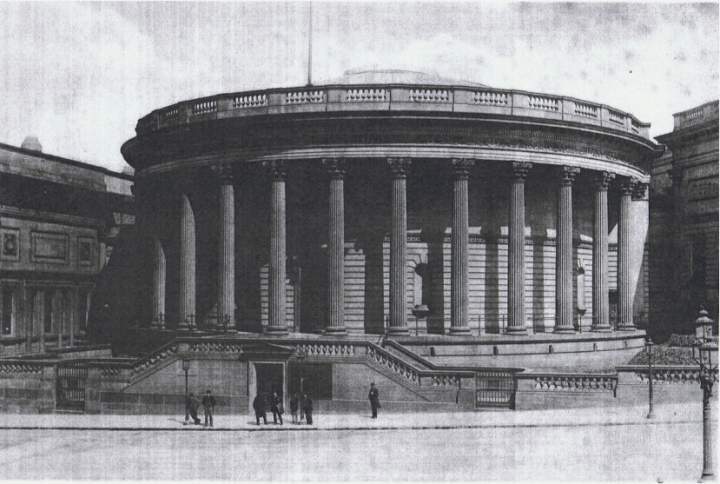
The Picton Reading Room, Liverpool, designed by Cornelius Sherlock and built in 1875–89 (photo: 1870s). Image courtesy Neil Sturrock via Victorian Web
Socially, libraries were advocated as a means of attracting the masses away from immoral or ‘irrational’ pastimes. Yet support for libraries, which mostly came from above, was not just about controlling working-class culture. Libraries were meant to be for the benefit of the very middle classes who endorsed them. Middle-class readers welcomed what in effect became mini British Museum reading rooms at the centre of provincial towns, initially in the Midlands and the north. Big town libraries, like those established in Manchester and Liverpool, were much better resourced than the private subscription and commercial libraries that the ‘respectable’ classes had relied on previously.
Library promoters also identified economic benefits. In 1850, in looking forward to the Great Exhibition scheduled for the following year, the Art Journal warned that Britain had yielded the ‘palm of excellence’ to French, German and Bohemian manufacturers in respect of goods that contained a critical artistic-design element. Library promoters argued that increased exposure to art and design through the provision of art books and artefacts in attached museums would improve the quality of manufacturers because taste would be universally elevated and workers’ skills improved. While acknowledging the economic power of art, Edward Edwards, the country’s first public librarian, believed libraries could help relieve the alienating, dehumanising effect of industrialisation. He suggested that giving artisans access to books would not only ‘solace the intervals of toil’ but also ‘put new meaning in the toil, and new life in the toiler’. Linked to this was the idea that a library offered sanctuary from an urbanising society in which the pace and stresses of life were rapidly increasing.
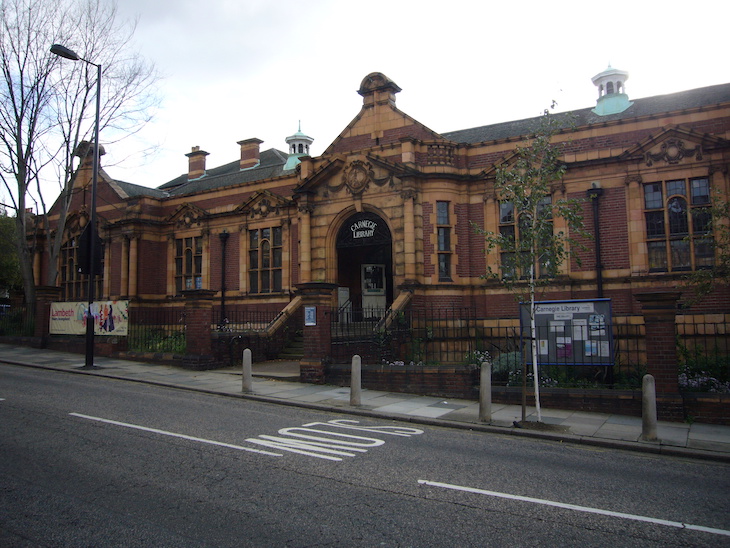
The Carnegie Library in Herne Hill, London, funded by a grant from Andrew Carnegie, designed by Wakeford and Sons and opened in 1906. Photo: Tom Betts/Wikimedia Commons
These pioneering motivations encapsulate the dynamism that was to characterise the public library over the next century and a half: a public institution that sought to satisfy both aesthetic and material human impulses. The public library carried these philosophical credentials with it through subsequent crisis. During the Lancashire cotton famine in the 1860s, libraries provided refuge for swathes of unemployed textile workers, who were praised for reading, not rioting. Around the turn of the century, as imperial rivalry intensified, as Britain’s economic hegemony was threatened and as fears escalated around the degeneration of the ‘race’, strong educational and ‘national efficiency’ notes were sounded. These were reflected in the upgrading of reference services and the growth of children’s libraries – aided in no small measure by the ‘collectivist self-help’ philosophy of American industrialist Andrew Carnegie, who donated funds for the construction of hundreds of library buildings.
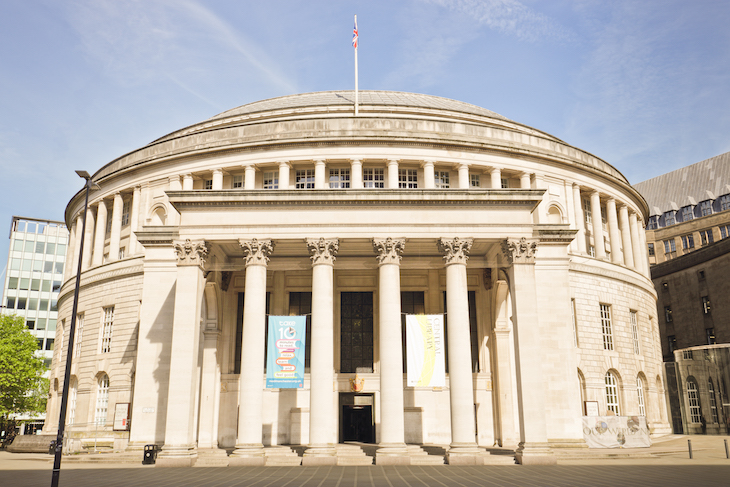
Manchester Central Library, designed by E. Vincent Harris and constructed between 1930 and 1934. Photo: Michael D. Beckwith/Wikimedia Commons
In 1914, many librarians went to war, and there were other interruptions to service, but reading for light relief as well as about the causes of the conflict and other international matters increased in popularity. Technical and commercial departments were inaugurated in the context of the reconstruction effort, which was partly aimed at guarding against the spread of revolutionary ideas. Reconstruction also gave rise to reformed legislation (in 1919), which allowed county councils to open libraries, thereby giving library access to millions in rural areas for the first time. During the Great Depression of the 1930s, libraries offered distraction from the misery of daily life. In the Second World War, 50 libraries were destroyed or severely damaged. Those that survived the bombing were blacked out, but the opening hours of many were lengthened and a massive boom in reading was accommodated, as people sought diversion and ways to maintain morale.
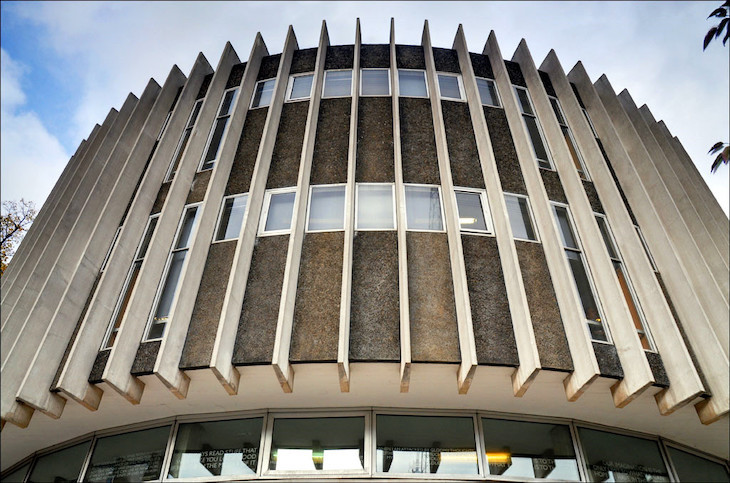
Swiss Cottage Library, London, designed by Sir Basil Spence, Bonnington and Collins in 1964. Photo: George Rex/Wikimedia Commons (image used under Creative Commons license [CC BY-SA 2.0])
A massive library building programme in the post-war period helped drag the country out of austerity. The bold, concrete-and-glass modernist libraries of the 1960s, alongside a new Public Libraries Act in 1964 – which for the first time made the provision of a ‘comprehensive’ library service by local authorities compulsory – represented a huge investment in the public library ideal. This was coupled with a more vocal discussion about disadvantaged members of society who had been informally excluded from library services, among them alienated young people and ethnic minorities. For such people, it was argued, libraries might just as well not have been open.
To rectify these inequalities and move away from a universal, one-size-fits-all approach, attempts were made in the 1970s and 1980s to develop a ‘community librarianship’ mode of service delivery, which sought to de-institutionalise the library service, engage with local communities, identify and work with existing grassroots organisations and, above all, prioritise the needs of the disadvantaged, the culturally excluded and – a term more widely used then than now – the underclass. This strategy ran alongside and prefaced more populist initiatives in the form of the provision of new materials and services, from audio and video tapes (1980s) and CDs (1990s) to internet access (late 1990s) and DVDs (2000s). In reaction, these innovations prompted claims – which continue to circulate – that libraries and librarians should not be, respectively, entertainment centres or social workers. Rather, services should go back to basics and revolve around books.
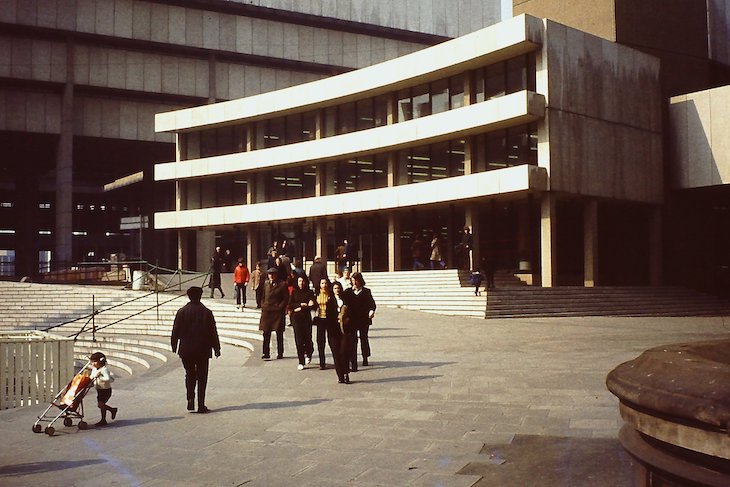
Birmingham Central Library (demolished 2016), designed by John Madin and Partners in 1974. Photo: Mark Warrick/Flickr (used under Creative Commons licence [CC BY-SA 2.0])
Such cultural tensions associated with libraries were in some respects a revival of the Victorian fiction debate about the place of the popular novel in libraries. Librarians and library promoters urged users to climb a cultural ladder in search of ever ‘better’ reading; but they knew they had to provide digestible imaginative literature to attract readers in the first place. The conundrum for libraries has always been how to satisfy the demands of disparate social and cultural groups. Negotiating this has generated images of libraries that range from ‘people’s university’ to ‘soup kitchen’. Perhaps apt in today’s current climate, library books were often regarded as potent sources of infectious disease. In 1904, for example, one library handbook advised the adoption of a ‘track and trace’ system: libraries should supplement their register of readers with a street-by-street log of individual houses and the library users residing therein, largely for the purpose of isolating books from those addresses reported by the medical authorities to be carrying an infectious disease. In the early 20th century, some libraries fumigated books borrowed by readers from infected households. Yet the evidence on the infectiousness of books was flimsy, no doubt given popular credence by the emergence of germ theory, which replaced the earlier miasmatic theory of contagion that had partly driven the close attention paid by libraries to ventilation in the first decades of their existence.
The coronavirus pandemic may prove to be a challenge that dwarfs the many episodes of anxiety and crisis through which the public library has lived in the past. In a post-Covid world, however, the public library’s resilience will stand it in good stead, especially if its potential to support policies for regeneration, levelling up and the promotion of well-being is meaningfully acknowledged through adequate resourcing.
Alistair Black is Professor Emeritus in the School of Information Sciences, University of Illinois at Urbana-Champaign, USA. He has written widely on the history of libraries and information, including in his most recent book, Libraries of Light: British Public Library Design in the Long 1960s (Routledge, 2019).

Public libraries have been vital in times of crisis – from conflict to Covid-19
Chelsea Public Library (detail; 1920), Malcolm Drummond. Leicester Arts and Museums Service
Share
The recent blanket closure of public libraries in Britain due to the coronavirus pandemic obscures the fact that in the decade of austerity that preceded it hundreds of service points had already closed their doors. Most of those that remained open were in crisis, grappling with slashed budgets and reliant on volunteers, who now outnumber paid staff three to one. Increasingly, paid staff are on casual contracts, many being merely hourly paid. The number of qualified, professional staff – the very people needed to ‘fight fires’ and innovate in a period of decline – has significantly decreased.
The public library is no stranger to crisis and has often flourished in times of wider emergency. The idea of providing tax-based local libraries was born during the first major crisis of industrial capitalism, against the backdrop of Chartist agitation. Whereas some European countries got bourgeois revolutions (in 1848), Britain got public libraries; the Public Libraries Act, which allowed local authorities to establish free public libraries, arrived on the statute book in 1850.
In political terms, it was said that public libraries could make workers less hot-headed and more reasonable. Libraries could serve as antidotes to populist demagogues and ‘dangerous’ ideas, and give workers an education that would enable them to appreciate the virtues of the rising free-market system. This is not to say that political debate was outlawed. It was said that library shelves were a place where the wolf could lie side-by-side with the lamb. Newsrooms became libraries’ most popular department, their contents representing a variety of opinion – though within acceptable, establishment parameters. In some respects, newsrooms were the internet broadband of their day, although, for many decades, they remained largely male preserves.
The Picton Reading Room, Liverpool, designed by Cornelius Sherlock and built in 1875–89 (photo: 1870s). Image courtesy Neil Sturrock via Victorian Web
Socially, libraries were advocated as a means of attracting the masses away from immoral or ‘irrational’ pastimes. Yet support for libraries, which mostly came from above, was not just about controlling working-class culture. Libraries were meant to be for the benefit of the very middle classes who endorsed them. Middle-class readers welcomed what in effect became mini British Museum reading rooms at the centre of provincial towns, initially in the Midlands and the north. Big town libraries, like those established in Manchester and Liverpool, were much better resourced than the private subscription and commercial libraries that the ‘respectable’ classes had relied on previously.
Library promoters also identified economic benefits. In 1850, in looking forward to the Great Exhibition scheduled for the following year, the Art Journal warned that Britain had yielded the ‘palm of excellence’ to French, German and Bohemian manufacturers in respect of goods that contained a critical artistic-design element. Library promoters argued that increased exposure to art and design through the provision of art books and artefacts in attached museums would improve the quality of manufacturers because taste would be universally elevated and workers’ skills improved. While acknowledging the economic power of art, Edward Edwards, the country’s first public librarian, believed libraries could help relieve the alienating, dehumanising effect of industrialisation. He suggested that giving artisans access to books would not only ‘solace the intervals of toil’ but also ‘put new meaning in the toil, and new life in the toiler’. Linked to this was the idea that a library offered sanctuary from an urbanising society in which the pace and stresses of life were rapidly increasing.
The Carnegie Library in Herne Hill, London, funded by a grant from Andrew Carnegie, designed by Wakeford and Sons and opened in 1906. Photo: Tom Betts/Wikimedia Commons
These pioneering motivations encapsulate the dynamism that was to characterise the public library over the next century and a half: a public institution that sought to satisfy both aesthetic and material human impulses. The public library carried these philosophical credentials with it through subsequent crisis. During the Lancashire cotton famine in the 1860s, libraries provided refuge for swathes of unemployed textile workers, who were praised for reading, not rioting. Around the turn of the century, as imperial rivalry intensified, as Britain’s economic hegemony was threatened and as fears escalated around the degeneration of the ‘race’, strong educational and ‘national efficiency’ notes were sounded. These were reflected in the upgrading of reference services and the growth of children’s libraries – aided in no small measure by the ‘collectivist self-help’ philosophy of American industrialist Andrew Carnegie, who donated funds for the construction of hundreds of library buildings.
Manchester Central Library, designed by E. Vincent Harris and constructed between 1930 and 1934. Photo: Michael D. Beckwith/Wikimedia Commons
In 1914, many librarians went to war, and there were other interruptions to service, but reading for light relief as well as about the causes of the conflict and other international matters increased in popularity. Technical and commercial departments were inaugurated in the context of the reconstruction effort, which was partly aimed at guarding against the spread of revolutionary ideas. Reconstruction also gave rise to reformed legislation (in 1919), which allowed county councils to open libraries, thereby giving library access to millions in rural areas for the first time. During the Great Depression of the 1930s, libraries offered distraction from the misery of daily life. In the Second World War, 50 libraries were destroyed or severely damaged. Those that survived the bombing were blacked out, but the opening hours of many were lengthened and a massive boom in reading was accommodated, as people sought diversion and ways to maintain morale.
Swiss Cottage Library, London, designed by Sir Basil Spence, Bonnington and Collins in 1964. Photo: George Rex/Wikimedia Commons (image used under Creative Commons license [CC BY-SA 2.0])
A massive library building programme in the post-war period helped drag the country out of austerity. The bold, concrete-and-glass modernist libraries of the 1960s, alongside a new Public Libraries Act in 1964 – which for the first time made the provision of a ‘comprehensive’ library service by local authorities compulsory – represented a huge investment in the public library ideal. This was coupled with a more vocal discussion about disadvantaged members of society who had been informally excluded from library services, among them alienated young people and ethnic minorities. For such people, it was argued, libraries might just as well not have been open.
To rectify these inequalities and move away from a universal, one-size-fits-all approach, attempts were made in the 1970s and 1980s to develop a ‘community librarianship’ mode of service delivery, which sought to de-institutionalise the library service, engage with local communities, identify and work with existing grassroots organisations and, above all, prioritise the needs of the disadvantaged, the culturally excluded and – a term more widely used then than now – the underclass. This strategy ran alongside and prefaced more populist initiatives in the form of the provision of new materials and services, from audio and video tapes (1980s) and CDs (1990s) to internet access (late 1990s) and DVDs (2000s). In reaction, these innovations prompted claims – which continue to circulate – that libraries and librarians should not be, respectively, entertainment centres or social workers. Rather, services should go back to basics and revolve around books.
Birmingham Central Library (demolished 2016), designed by John Madin and Partners in 1974. Photo: Mark Warrick/Flickr (used under Creative Commons licence [CC BY-SA 2.0])
Such cultural tensions associated with libraries were in some respects a revival of the Victorian fiction debate about the place of the popular novel in libraries. Librarians and library promoters urged users to climb a cultural ladder in search of ever ‘better’ reading; but they knew they had to provide digestible imaginative literature to attract readers in the first place. The conundrum for libraries has always been how to satisfy the demands of disparate social and cultural groups. Negotiating this has generated images of libraries that range from ‘people’s university’ to ‘soup kitchen’. Perhaps apt in today’s current climate, library books were often regarded as potent sources of infectious disease. In 1904, for example, one library handbook advised the adoption of a ‘track and trace’ system: libraries should supplement their register of readers with a street-by-street log of individual houses and the library users residing therein, largely for the purpose of isolating books from those addresses reported by the medical authorities to be carrying an infectious disease. In the early 20th century, some libraries fumigated books borrowed by readers from infected households. Yet the evidence on the infectiousness of books was flimsy, no doubt given popular credence by the emergence of germ theory, which replaced the earlier miasmatic theory of contagion that had partly driven the close attention paid by libraries to ventilation in the first decades of their existence.
The coronavirus pandemic may prove to be a challenge that dwarfs the many episodes of anxiety and crisis through which the public library has lived in the past. In a post-Covid world, however, the public library’s resilience will stand it in good stead, especially if its potential to support policies for regeneration, levelling up and the promotion of well-being is meaningfully acknowledged through adequate resourcing.
Alistair Black is Professor Emeritus in the School of Information Sciences, University of Illinois at Urbana-Champaign, USA. He has written widely on the history of libraries and information, including in his most recent book, Libraries of Light: British Public Library Design in the Long 1960s (Routledge, 2019).
Unlimited access from just $16 every 3 months
Subscribe to get unlimited and exclusive access to the top art stories, interviews and exhibition reviews.
Share
Recommended for you
A new tower of Babel rises in the Bodleian Library
We know what translation can do – but what does it look like? Eight centuries of multilingual activity is on show in Oxford
Is the system for protecting historic buildings working?
The procedures for protecting England’s historic buildings are now 70 years old. Is the system still fit for purpose?
Finally, a reminder that post-war architecture deserves our praise
Elain Harwood’s magisterial Space, Hope, and Brutalism is a triumph